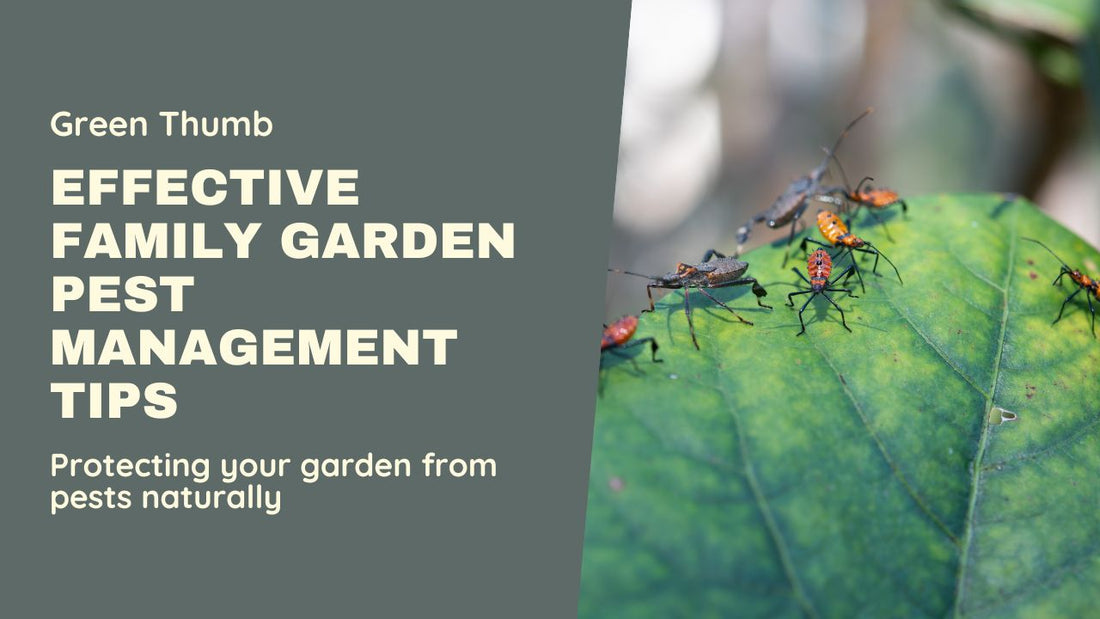
Effective Family Management: Balancing Homeschooling and Garden Pest Control
Share
Family Management of Kids and Pest Control in the Garden
Balancing family management and gardening, particularly when it comes to dealing with pests, can be a significant challenge for many households. This blog will explore how to efficiently manage your children while also tackling pest control in the garden. We’ll provide practical tips on family management, discuss the role of intentional learning in a homeschooling environment, and offer effective strategies for keeping your garden pest-free.
Family Management with a Focus on Homeschooling
Managing a family, especially when homeschooling, requires a structured approach to ensure that all aspects of home life run smoothly. Here are some essential tips for effective family management:
1. Establish a Routine: A well-structured routine helps children understand what is expected of them throughout the day. Create a daily schedule that includes time for learning, chores, play, and relaxation. For example, mornings could be dedicated to academic activities, while afternoons can be reserved for outdoor play and garden time.
2. Set Clear Expectations: Communicate clearly with your children about their responsibilities. Use charts or lists to outline daily tasks and learning goals. Involve them in setting these expectations to increase their sense of ownership and responsibility.
3. Incorporate Intentional Learning: Intentional learning involves planning educational activities that are engaging and meaningful. This can include themed weeks where you focus on a particular subject, such as insects. Use a mix of hands-on activities, reading, and multimedia resources to explore the topic deeply.
4. Encourage Independence: Teach your children to work independently by gradually increasing the complexity of tasks they can do on their own. This not only boosts their confidence but also gives you more time to focus on other activities, such as gardening.
5. Foster a Positive Learning Environment: Create a dedicated learning space that is free from distractions. Ensure that it is well-organized and stocked with necessary supplies. A positive learning environment can significantly enhance your children’s focus and productivity.
Intentional Learning with a Focus on Insects
Incorporating a theme like insects into your homeschooling curriculum can be both educational and fun. Here’s how you can structure a week of intentional learning about insects:
Day 1: Introduction to Insects
- Activity: Take a nature walk to observe insects in their natural habitat. Encourage your children to take notes and draw pictures of the insects they see.
- Learning Objective: Understand the basic characteristics of insects and their role in the ecosystem.
- Resources: Insect identification guides, magnifying glasses, notebooks.
Day 2: Insect Anatomy and Life Cycle
- Activity: Create a diagram of an insect’s anatomy and discuss the different stages of its life cycle.
- Learning Objective: Learn about the body parts of insects and how they develop from eggs to adults.
- Resources: Diagrams, coloring sheets, life cycle charts.
Day 3: Types of Insects
- Activity: Research different types of insects and create a poster or digital presentation showcasing the diversity of the insect world.
- Learning Objective: Identify various types of insects and understand their unique features.
- Resources: Books, online databases, art supplies.
Day 4: Insect Habitats
- Activity: Build a small insect habitat in your garden or a container to observe insects up close.
- Learning Objective: Learn about the environments in which different insects thrive.
- Resources: Soil, plants, containers, observation journals.
Day 5: The Role of Insects in the Garden
- Activity: Discuss the benefits and challenges of having insects in the garden. Identify pests and beneficial insects.
- Learning Objective: Understand how insects affect the garden and how to manage them sustainably.
- Resources: Garden tools, insect guides, natural pest control methods.
Effective Pest Control Strategies
Now that we’ve covered family management and intentional learning, let’s focus on practical pest control strategies to keep your garden healthy and thriving:
1. Identify the Pests: Accurate identification of pests is crucial. Different pests require different management strategies. Use insect identification guides or consult with local gardening experts to determine what’s affecting your plants.
2. Natural Pest Control Methods: Consider using natural methods to control pests, as they are safer for your family and the environment. Here are some effective techniques:
- Companion Planting: Some plants naturally repel pests. For example, marigolds can deter aphids, and basil can repel mosquitoes.
- Beneficial Insects: Encourage beneficial insects like ladybugs, lacewings, and predatory beetles that prey on common garden pests.
- Neem Oil: This natural pesticide is effective against a wide range of pests. It disrupts the feeding and reproduction of insects.
3. Physical Barriers: Use physical barriers to protect your plants from pests. Floating row covers, netting, and fences can prevent insects and larger animals from accessing your garden.
4. Regular Monitoring: Regularly inspect your garden for signs of pest activity. Early detection can help prevent infestations from becoming severe. Check the undersides of leaves, stems, and soil for eggs, larvae, and adult pests.
5. Organic Pesticides: If natural methods are not sufficient, consider using organic pesticides. These are less harmful to beneficial insects and the environment compared to synthetic chemicals. Always follow the manufacturer’s instructions when applying any pesticide.
6. Proper Garden Maintenance: Maintain a healthy garden by practicing good horticultural practices. This includes proper watering, mulching, and pruning. Healthy plants are more resistant to pest damage.
7. Educate Your Children: Involve your children in the pest control process. Teach them to identify common pests and beneficial insects. This not only helps with garden management but also reinforces their learning about insects.
Balancing Garden Time and Family Time
Finding the right balance between spending time with your children and managing your garden is essential. Here are some tips to help you achieve this balance:
1. Involve the Kids: Involve your children in gardening activities. Assign them age-appropriate tasks like watering plants, pulling weeds, or harvesting vegetables. This not only lightens your workload but also provides them with hands-on learning experiences.
2. Schedule Garden Time: Dedicate specific times of the day or week for gardening. This ensures that you have uninterrupted time to focus on garden tasks while also making sure you have plenty of quality time with your children.
3. Make Gardening Fun: Turn gardening into a fun family activity. Organize garden scavenger hunts, plant themed gardens (like a butterfly garden), or have a family picnic in the garden. Making gardening enjoyable encourages your children to participate willingly.
4. Use Garden Time as a Learning Opportunity: Incorporate educational activities into your gardening routine. Discuss plant biology, the importance of pollinators, and sustainable gardening practices. Use gardening as a practical extension of your homeschooling curriculum.
5. Prioritize Tasks: Identify the most critical garden tasks and focus on those. It’s okay if not everything gets done at once. Prioritizing tasks helps you manage your time more effectively and reduces stress.
6. Take Breaks: Remember to take breaks and spend time relaxing with your family. Balance is key to preventing burnout and ensuring that both your garden and family life thrive.
Conclusion
Managing a family and a garden simultaneously can be challenging, but with proper planning and a structured approach, it is possible to succeed in both areas. Establishing routines, setting clear expectations, and incorporating intentional learning into your homeschooling curriculum can create a harmonious and productive home environment. By using natural pest control methods and involving your children in gardening activities, you can maintain a healthy garden while spending quality time with your family. Embrace the journey of family management and gardening as an opportunity for growth, learning, and connection.
